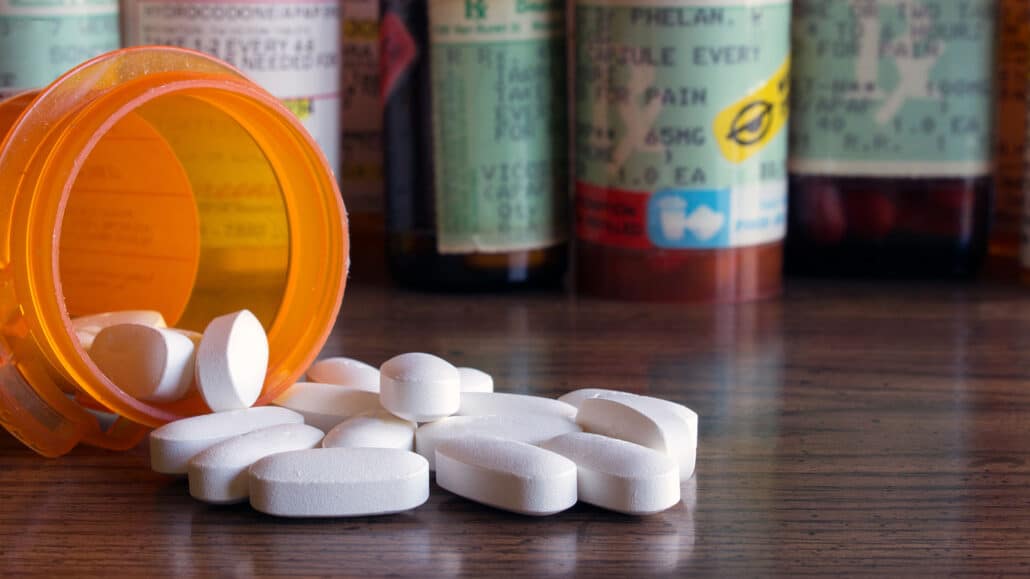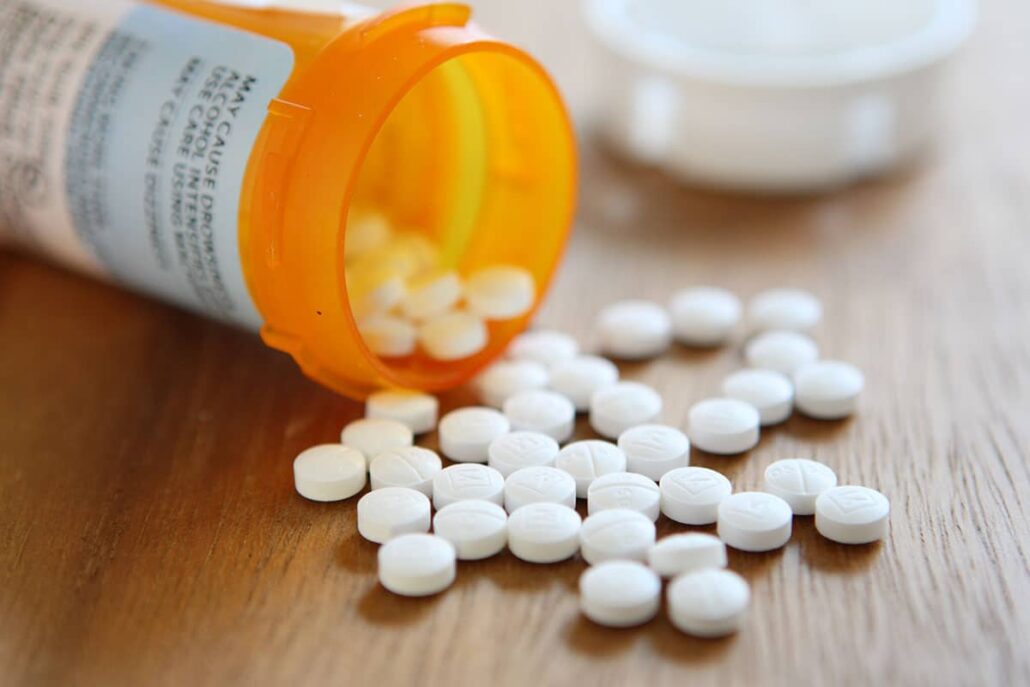One of the deadliest and most dangerous addictions is the abuse of the class of drugs called opioids. Originally developed as strong pain medications prescribed for reasons such as post-surgical pain or pain stemming from diseases like cancer, their abuse and the ensuing addiction problems have skyrocketed in recent years. If you think that someone you know is struggling with opioid abuse or addiction, learning about what opioid addiction and detoxing from it looks like and how to help them could save their life.

Table of Contents
What Are Opioids?
When someone is experiencing serious or chronic pain, they may be prescribed a drug from the class of opioids. Heroin is also a type of opioid that was originally developed as a prescription medicine. One aspect that sets opioids apart from many other prescription medications is that even when they are used as directed, opioid addiction can still occur since prolonged usage can create a dependency on the drug. Those who become addicted to opioid substances will also go through unpleasant withdrawal symptoms when they detox and remove the drug from their body.
People who misuse opioids are at risk of developing an opioid use disorder (OUD), regardless of whether the medicine was initially medically necessary or they began using the drug on their own. Those who misuse opioids may take more of the drug than was originally prescribed or may even take a prescribed dose given to someone else. This misuse of illicit opioids can lead to an opioid disorder that makes detoxing and recovering from addiction even more difficult.
Why Are Opioids So Addictive?
The main reason why opioids are so commonly abused is that they have a two-pronged effect on the user. First, when someone uses an opioid, the brain increases the production of dopamine, the chemical responsible for making us feel good. When we do activities that we enjoy, like riding a bike or spending time with someone we love, our brain releases dopamine to give us that happy, pleasant feeling. The use of opioids mimics this natural, positive feeling, tricking users into wanting more of that feeling, leading them toward misuse or even addiction. In addition to creating this dopamine-induced peaceful feeling, opioids also block pain signals between the brain and the body by binding to the receptors in the brain responsible for sending them. This blockage dulls the brain’s perception of pain, acting as a pain relief mechanism for those with chronic or severe pain or simply reducing any painful feelings a user may be experiencing. By increasing dopamine production and reducing pain, opioid users quickly become used to the positive feelings produced by ingesting this class of drug, leading to its repeated use and potential addiction.
Common Opioids
To better understand how opioid detox works, you need to know which drugs fall into the opioid class. The following list encompasses the most common substances classified as opioids:
- Codeine
- Fentanyl (prescribed as Actiq, Duragesic and Sublimaze)
- Hydrocodone (also known as Vicodin)
- Hydromorphone (prescribed as Dilaudid)
- Meperidine (prescribed as Demerol)
- Morphine
- Oxycodone (also known as Oxycontin and Percocet)
- Oxymorphone (prescribed as Opana)
- Tapentadol (also known as Nucynta)
- Tramadol (also called Ultram)

Opioid Withdrawal: What it Looks Like
Those who have misused, abused, or even used opioids according to their prescription will experience unpleasant sensations when they reduce the opioids they are taking or stop taking them completely. This reaction is called withdrawal, and it can present a very serious situation for those who are addicted to this class of drugs. Anyone who is dependent on the drug can experience mild symptoms or all of the withdrawal symptoms, but those who quit suddenly or reduce their dose quickly may be more prone to a severe withdrawal experience. Typical withdrawal symptoms are:
- Anxiety
- Bone and muscle pain
- Chills
- Diarrhea
- Increased body temperature
- Insomnia
- High blood pressure
- Nausea and vomiting
- Racing heart
- Sweating
Withdrawal Timelines
Taking opioids over a long period allows a person to build up their tolerance to the drug, leading to dependence. Those with tolerance to opioids will need more of the drug over time to experience the same euphoric feeling and pain relief that they experienced earlier with a smaller amount of the drug. When an addicted person stops using opioids, some feel the symptoms of withdrawal very quickly, while other opioids take longer to produce feelings of withdrawal. While each person’s experience may vary based on the amount of drugs they have used and the length of time of their addiction, most opioids have an expected timeline for when the user will begin to experience withdrawal.
Short-acting Opioids (Heroin): 8-12 hours for first symptoms to appear from last use; peak withdrawal symptoms occur within 1-3 days of last use; symptoms may last up to 7 days from the last use of the drug.
Short-acting Opioids (Morphine) and Immediate Release Opioids (Oxycodone, Hydrocodone, and Fentanyl): Withdrawal symptoms may appear in 8-24 hours following their last use; withdrawal can last up to 10 days from the last drug use.
Long-acting or Extended-release/Controlled-release Opioids (Fentanyl, Hydrocodone, methadone, Morphine and Oxycodone): Withdrawal symptoms can begin as long as 36 hours after ingesting the drug; withdrawal may take up to 14 days or longer for these variants of opioids.

Can You Die from Opioid Withdrawal?
Having a high tolerance and resulting dependence on opioids can lead to dangerous conditions like extreme drowsiness, slowed breathing, and nausea. While these combined symptoms can put users in danger, withdrawal doesn’t typically lead to loss of life, although the symptoms can be extremely uncomfortable. For those with pre-existing medical conditions or health problems brought on by extended drug use, withdrawal and detox from opioids can be more dangerous and should be done under the care and treatment of medical and mental health professionals. Those struggling with addiction who become dehydrated from nausea and diarrhea while attempting to withdraw from opioids but then return to drug use may be at the greatest risk of overdosing.
Opioid Detox
Those seeking to release themselves from their opioid addiction will likely encounter a very uncomfortable withdrawal and detoxing period. But completing a successful detox from opioids doesn’t have to be something you face alone. Many people choose to enlist the aid of a detox center that can help manage the unpleasant symptoms and sometimes life-threatening circumstances that come with detox and withdrawal. For many seeking support, specific medicines can ease detox when supervised by a qualified detox center.
Buprenorphine
This medicine is used to minimize the unpleasant symptoms of withdrawal and reduce cravings for more opioids. Buprenorphine is also used to help taper users off opioids, which can assist during the detox and treatment phases. Suboxone, a combination of buprenorphine and naloxone, is often prescribed for a longer period to help with cravings and minimize the risk of overdose for those fighting opioid addictions.
Methadone
Like buprenorphine, methadone is prescribed to someone trying to taper down from opioid use because it helps reduce the cravings for increased amounts of the drug while also diminishing the uncomfortable symptoms of withdrawal. The use of methadone often persists long after a person is detoxed from opioids, as it can help with long-term craving control and helps former addicts stay clean and avoid the use of other opioids or illicit drugs.
Other Medicines Used in Detox
Many people detoxing from opioids experience anxiety over the detoxing and onset of withdrawal symptoms, so often clonidine is prescribed to help. When potentially dangerous symptoms like diarrhea occur during detoxification, medical professionals may prescribe loperamide to prevent the person from becoming dehydrated from this unpleasant symptom that could become deadly in some people.

Detox and Treatment for Opioid Addictions
Those fighting against opioid misuse or abuse can find relief with medical and mental health support during the challenges of detox and treatment for this addiction. Detox centers provide around-the-clock medical supervision to help those who are in the process of ridding opioids from their bodies. While the timeframe varies according to factors like how long someone has used opioids and their tolerance levels, detox centers provide personalized support and medical interventions during this potentially difficult time. For those facing opioid addiction, detox is only the first step in the process of fighting drug abuse and misuse. Supervised treatment like the programs offered at Long Island Interventions provides the next step in addiction recovery.
Let Long Island Interventions Help
If you or someone you know is in need of detoxification and treatment for opiate addiction, contact Long Island Interventions to help get you on the path to recovery. Our professional staff can help you find the detox program with one of our trusted affiliate providers that will support a healthy, safe detox to prepare for addiction treatment. We care about your recovery from opioid addiction and want to help you or your loved one move towards a healthier life, free from addiction.
Addiction Treatment After Detox
After you detox, you still need to build the necessary skills to sustain a sober lifestyle. Addiction rehab programs provide individual therapies, group therapy, holistic therapies, and other addiction treatments to help patients better regulate their emotions and resist the temptation to relapse. Every patient has unique needs, so the professionals at an addiction recovery center will take all aspects of your situation into account to help you pick the right treatment program. This comprehensive approach often involves medication-assisted treatment (MAT), which is an evidence-based practice supported by the Substance Abuse and Mental Health Services Administration (SAMHSA).
Medication-Assisted Treatment (MAT)
MAT involves using FDA-approved medications, such as naltrexone, in combination with counseling and behavioral therapies, to provide a “whole-patient” approach to the treatment of substance use disorders. MAT is used primarily for the treatment of opioid use disorder (OUD), but it is also used for alcohol use disorder. The goal of MAT is to provide a comprehensive, tailored approach to the treatment of substance abuse, helping to sustain recovery and prevent overdose deaths.
Support Groups and Behavioral Therapy
Support groups and behavioral therapy are critical components of any addiction treatment program. These resources provide a network of care that can help individuals through the recovery process, offering emotional support and practical advice for dealing with cravings and avoiding relapse.
Public Health and Opioid Treatment
Opioid addiction is not just a personal issue but a significant public health concern. The Centers for Disease Control and Prevention (CDC) and the Department of Health are actively involved in providing guidelines and support for opioid treatment programs. These organizations recognize the need for comprehensive treatment services that include medical detox, inpatient and outpatient treatment options, and ongoing support through community resources and healthcare providers.
Please contact Long Island Interventions for information about Opioid Addiction Treatment near you. We are dedicated to helping individuals overcome opioid addiction and achieve long-term recovery.
FAQ
What are the three main types of opioids?
What is the difference between opioid tolerance and dependence?
What do opioids metabolized into?

